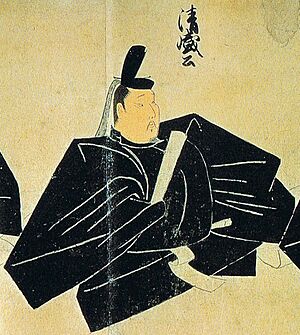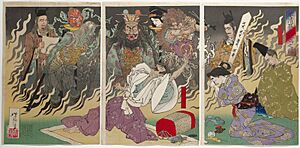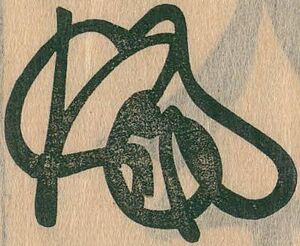Taira no Kiyomori facts for kids
Quick facts for kids
Taira no Kiyomori
平清盛 |
|
|---|---|

Taira no Kiyomori
|
|
| Born | 1118 |
| Died | March 20, 1181 Heian-kyō, Japan
|
| Nationality | Japanese |
| Occupation | military leader, kugyō |
Taira no Kiyomori (平 清盛, 1118 – March 20, 1181) was a powerful military leader in Japan. He lived during the late Heian period. Kiyomori was famous for creating the first government in Japan that was controlled by samurai warriors. Before him, nobles and emperors held most of the power.
Contents
Early Life of Kiyomori
Kiyomori was born in Japan in 1118. He was the first son of Taira no Tadamori. His mother, Gion no Nyogo, was a servant in the palace. This is according to an old Japanese story called The Tale of the Heike.
Kiyomori's Family
Father: Taira no Tadamori
Mother: Gion no Nyogo (died 1147)
Wife: Taira no Tokiko
Children:
- Taira no Shigemori
- Taira no Munemori
- Taira no Tomomori
- Taira no Tokuko
- Taira no Shigehira
Kiyomori's Rise to Power
After his father died in 1159, Kiyomori took charge of the Taira clan. He wanted to gain more political power. In 1156, Kiyomori and Minamoto no Yoshitomo, who led the Minamoto clan, worked together. They stopped a rebellion called the Hōgen Rebellion. This made both the Taira and Minamoto clans the strongest samurai groups in Kyoto.
However, this alliance soon turned into a rivalry. Four years later, in 1160, they fought each other in the Heiji Rebellion. Kiyomori won this war. Yoshitomo's two oldest sons were killed. Kiyomori became the leader of the most powerful warrior clan in Kyoto. He showed mercy to some of Yoshitomo's surviving sons. He sent them away from the capital. These sons included Yoritomo, Noriyori, and Yoshitsune. This act of kindness would later lead to the Taira clan's downfall.
Becoming Chief Minister
Because he led the only strong warrior clan, Kiyomori could influence the court. There was a power struggle between the retired emperor, Go-Shirakawa, and his son, Emperor Nijō. Kiyomori used this to his advantage. He moved up quickly in the government. Many of his family members also gained important positions.
In 1167, Kiyomori made history. He became the first warrior to be appointed daijō-daijin. This was the highest position in the government. It meant he was the main administrator of the imperial government. After a short time, he stepped down from this role. This was a common practice for high-ranking officials. They would leave the job but keep the honor and influence. Kiyomori wanted to show his strong position in the Kyoto government. However, many traditional noble families were not happy with his power.

Controlling the Imperial Court
In 1171, Kiyomori arranged for his daughter, Tokuko, to marry Emperor Takakura. Their first son, who would become Emperor Antoku, was born in 1178.
The next year, in 1179, Kiyomori took even more control. He removed his rivals from all government jobs. He then filled these positions with his own friends and family. He also put the retired Emperor Go-Shirakawa in prison. In 1180, Kiyomori forced Emperor Takakura to give up his throne. Prince Tokihito then became the new emperor, Emperor Antoku.
The Genpei War and Kiyomori's Death
Kiyomori's great power and wealth made many people turn against him. Even some members of his own clan were unhappy. Prince Mochihito, Emperor Takakura's brother, asked the Minamoto clan to fight the Taira. This started the Genpei War in 1180.
Kiyomori became very sick and died early the next year. The Tale of the Heike says his fever was so high that no one could get close to him without feeling burned. After his death, his son Munemori took over. However, the Taira clan was defeated by the Minamoto in 1185.
Images for kids
-
Taira no Kiyomori encounters the fox goddess Kiko Tennō (Dakiniten), by Utagawa Kuniyoshi
See also
 In Spanish: Taira no Kiyomori para niños
In Spanish: Taira no Kiyomori para niños
- Taira no Shigemori
- Shishigatani incident
- Fukuhara-kyō
- Itsukushima Shrine
- Siege of Shirakawa-den
Sources




